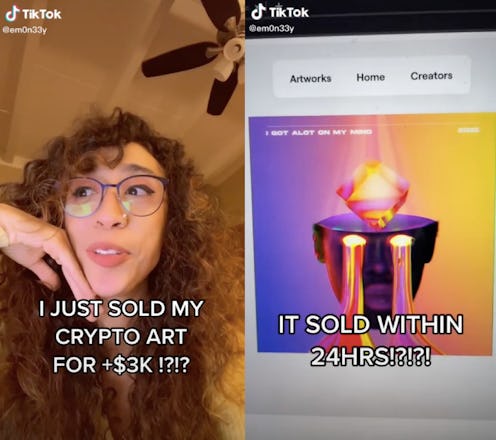Tech
WTF Is An NFT?
A cybersecurity expert explains the NFT craze.

The videos are not dissimilar to any other Grimes music video you can watch on YouTube — fantastical, other-worldly, futuristic. Yet at an auction the last week of February, thousands of copies of the digital artworks sold for over $5 million. But unlike other auctions, where the buyer walks away with a physical copy of the artwork, Grimes is still the owner of these NFTs, and anyone can watch the videos online for free.
If you're still kicking yourself for missing out on investing in Bitcoin or GameStop, you might want to wrap your head around the latest crypto-trend, Non-Fungible Tokens (NFTs) Despite existing mostly in cyberspace, NFTs are very real, and according to experts, valuable — at least culturally. Grimes isn’t the only one making bank on NFTs — independent artists and musicians are also cashing in on selling their artful “tokens,” and you can, too.
But WTF is an NFT? An NFT is a digital artifact — a graphic, text, photo or image, video, etc. — that can be sold via Blockchain. (Blockchain is a database and banking center for cryptocurrency.) A .gif of Nyan Cat — you know, the meme you’ve probably personally seen thousands of times — just sold for $600,000 as an NFT. Unlike Bitcoin or Ethereum, cryptocurrencies that can be used to buy NFTs, NFTs are not interchangeable, or “fungible.” This means that even though they are worth money, they are not considered money. You can't go to a store and buy a shirt with a shirt, right? But you could sell that shirt, elsewhere, because it has monetary value. That’s kind of what NFTs are.
How Do NFTs Work?
With NFTs, an artist can register their digital artifacts via Blockchain and turn them into sellable commodities. Because the original art has now been registered — through Blockchain, you can give the digital file a serial number that stores all its unique information — it's more valuable than if an artist just tried to put a paywall on a downloadable .gif. It’s like how you can Google Monet’s “Water Lilies” and enjoy the artwork, but you can only own it — or later, sell it for a profit — if you buy it at auction. The difference, however, is that the artist still owns the copyright to the artwork, and gets a percentage of future sales thanks to how Blockchain works.
Cyber security expert Kristina Podnar tells Bustle that though they are a "risky" investment and "unregulated and unproven" in nature, it might be a worthwhile risk if you can afford it. "I wouldn’t place my rent money into NFTs, but if you are adventurous and looking to get in on the right floor for investment (and can understand which NFT platform to leverage) you may be well rewarded through the coming 18 to 24 months, especially as more individuals jump on board and create liquidity in the NFT market," she tells Bustle.
When Did NFTs Start?
NFTs have been in play for a few years already, though their exact inception is up for debate. According to Podnar, colored coins (a small denomination of a bitcoin) which came out in 2012, were very first NFTs. “Some purists look to 2016/2017 as the starting point because that is when cards, counterparties and memes started in the marketplace,” she tells Bustle. “They came about with Blockchain because we finally had a way to validate that something is authentic, or scarce, and use them in unique digital arts like online games or art.” Similar cyber-collectables, like Rare Pepe, and CryptoKitties, are also old news. So why are we hearing about it now? According to Podnar, the pandemic has driven more people to rely on the digital entertainment industry, which has "rapidly increased the value of NFTs." Adding to that, the participation from influencers and mainstream art institutions like Christie’s has created a lot of recent buzz.
How Do You Buy NFTs?
While there are a number of marketplaces where you can buy NFTs, OpenSea is the largest cryptomall. There, you can peruse an endless scroll of digital masterpieces and memes costing from a fraction of a penny to hundreds of thousands of dollars. But like Beanie Babies or Bitcoin, there's really no way of knowing how and when they will be valuable, and how that value will transfer to traditional currency. (Plus, there’s the fact that cryptocurrency has a massive carbon footprint, due to the exorbitant amount of energy it uses to run its systems.)
If it's meaningful for you to the be the owner of something that's currently very culturally relevant, then you might be in the market for an NFT. If not, then enjoy knowing what an NFT is when your less-online friends ask you about it.